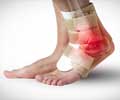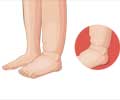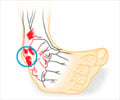University of Florida researchers have warned parents in the southeastern United States, that warm-weather activities like having a barbecue, roasting marsh mallows in a campfire or burning yard debris that create lasting childhood memories could lead to pediatric foot and ankle burns.
In what is thought to be the largest such evaluation to date, UF burn experts found that 69 percent of the 155 pediatric foot and ankle burns reviewed were caused by children walking on hot ashes, coals and embers – with some injuries occurring as long as a day or more after the fires were thought to be extinguished. Most of these youngsters were barefoot or wearing footwear that did not fully cover their feet, such as sandals.“We wanted to look at our experience with these burns because it appeared to us, anecdotally, that we were treating a fair number of children with burns isolated to the feet,” said Elizabeth Beierle, M.D., a UF associate professor of pediatric surgery and the principal investigator of the study, published in the January/February edition of the Journal of Burn Care and Research. “We felt that there may be a pattern that could be identified that would lead us to potentially develop prevention strategies.”
In the retrospective study, researchers used hospital and pediatric surgery databases to identify patients ages 8 months to 17 years admitted to the Shands at UF Burn Center between September 1992 and February 2006.
Two-thirds of the ash burns occurred after children came into contact with burning yard waste or garbage, nearly a third were caused by campfires and 6 percent involved encounters with a barbecue.
About half of the total cases studied – which also included scald, flame or contact burns – were classified as second-degree burns, and more than a third were third-degree burns, the most serious type.
“Clearly they’re not going to have this problem in Manhattan, where most people don’t even have space for a backyard,” Beierle said. “I think this is a problem in rural areas with warm weather because it tends to be more common to burn trash and leaves in the backyard in these areas.”
Advertisement
“The study is a great review of these burn cases because it shows how the origins of these injuries tend to be region-specific,” he said. “We see about two to three cases a month, and in about half of the instances, the accidents occurred on the beach from kids running over ashes and hot sand that were supposed to extinguish a bonfire.”
Advertisement
“The classic story is that a 2-year-old goes running outside through the ashes without footwear and gets burned,” Beierle said. “In many cases parents burned yard trimmings or trash and didn’t put water on the underlying coals to properly extinguish the fire. They just thought it was out because there weren’t open flames any longer.”
Cruse said the burns can be easily prevented by using common sense when families make outdoor fires.
“Parental supervision is paramount and proper closed footwear is also very important in the presence of a fire,” he said. “But the best preventative modality is to learn how to extinguish the fires appropriately. The best resource that tells you how to do that is the Boy Scouts of America handbook.”
Although a smaller percentage of the ash foot and ankle burns required skin grafting compared with the other types of burns studied, the average hospital stay was five days, which is valuable time lost for both the children and their parents, Beierle said.
“For a child or a parent, that’s five days out of school or five days out of work, often for both parents,” she said. “It’s not only a physically painful experience for the child and his or her family, but it has a painful economic impact as well. The point is that this is an easily preventable injury.”
Source-Eurekalert
THK/L











